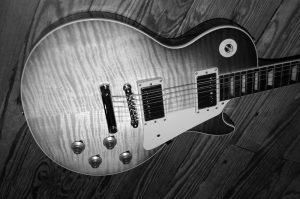This excerpt is from our October 2023 issue.
“When we try to pick out anything by itself, we find it hitched to everything else in the universe.”
—John Muir
Shake it, don’t break it. If ever there was a mantra around here these days, that’s it. Life is quite a ride in the ever-brief time we are spinning around on this magical piece of dirt hurtling through the ether. Heading into fall and the holidays, perhaps you find yourself in a funky groove. The morning alarm clock, just plodding along to whatever your gig is day in and day out. The cliché food groups of Stratocasters and Les Pauls scattered around you. We’d bet a chunk of hard-earned cash you even have heaps of unloved, uninspiring pedals sitting in drawers.
Sell them. Oh, there is a simple cure for this rote and menial, and we’ve encouraged you a few times. Homegrown is a good thing. Rolling your own, baby−stretching your wings with a whimsical guitar build that takes you out of your usual romps. Don’t worry about a thing, just grab a few parts and viola’. Our guts are always right, so trust yours. Listen to the emotions swirling under your breastbone, and when you find a vibey body or neck that speaks to you get to it. Create something special.
Why a Jazzmaster? For decades, our life consisted of chasing waves to surf around the world alone when we weren’t cranking guitars and playing in bands. From Mozambique to Peru, Fiji to South Africa, and all points in between. Our gig was as a staff writer for a fancy California surfing mag. Getting paid to surf is about as wonderful as getting paid to play music. We always wondered if the cops were going to show up and tell us we were having too much fun, the jig is up. But they never did.
Eventually, we found peace with water. We just woke up one day and realized we had done it, followed the muse, and were satisfied. The surf world is as radically small as the music world, and studying the early days of it, we’ll admit we have always been cosmically inspired when we hear Ventures tunes and other groovy sixties instrumentals pouring out of the vinyl album turntable speakers, or even on a short-wave AM radio while sleeping on a cliff in El Salvador. Surf music rules. It is so good for the heart, can keep you young, let alone puts a mile-wide grin across your face. And we’ll count Link Wray in there with his whoopass tune “Rumble,” too.
You could choose a few likely guitars for surf grooves, but our money has always been on the dark horses in life, the underdogs who come from behind and leave the rest of the world in their taillights. A good Jazzmaster can change your stars. And let us announce it right here, right now, there is NO Fender clean as remotely as amazing as a Jazzmaster neck pickup. There is nothing even close. It is supreme.

We decided to find one of the most secretly hallowed underground cheap thrill versions of the Jazzmaster, and also build our own wicked custom ToneQuest Jazzmaster using the finest parts known to earth and tell you a story or two of what happened once the dust settled on our pair of guitars. We had no idea the ramble would take us from Dallas to northern Minnesota, southern California, Oklahoma, Virginia, Missouri, Washington, an island in the San Juans, and back home to Texas. But that’s what happens when you go full-bore in life. When you go the distance and trust that leap of faith over the Grand Canyon of tone, you get handsomely rewarded. And yes, you bet your ass there is always plenty to learn along the way.

The Squier J. Mascis Jazzmaster – Fender’s Worst Kept Secret

In 2013, we got a phone call from our Publisher Emeritus, David Wilson. He was quite fired up about the J. Mascis Jazzmaster, and he let us know that we, of all people, since our truck floorboards were filled with beach sand and there was surf wax on everything, needed to buy a Squier JM asap. David and I were the closest of friends, and those of you who have read ToneQuest for a while know him as your own family, too. Rarely did a day go by without us talking guitars and life, let alone all the gonzo hangs we had through the years. But I didn’t get around to grabbing one—until now.
They were made in China, and that alone could keep some who chase logo tone away from having something special for low dough. The necks are talked about often as being wonderful, and some players hack them away from the guitar and use it on their fancier builds. The bodies were made of basswood. Think that’s not a good call? Guess again. There’s nothing that special about alder, although it can be more than decent and get the job done. Alder was viewed by western loggers as a “weed tree” that grows as much as fifteen feet in five years. It is extremely workable in terms of accepting stains and finish and it resists splitting apart when used in furniture.
Leo Fender chose it to replace swamp ash because it was cheap and plentiful. Basswood is an exceptional choice for solid body guitars, yet still considered inferior by the usual fools who couldn’t play their way out of a wet paper sack but prefer to talk about guitars all day on the internet. Around here, we like to play guitars. Remember that “Frankenstrat” that Eddie Van Halen changed the guitar world with? That was basswood. Basswood has a beautiful midrange, which is where the juju is in a great guitar. Keep your mind open and use your ears and heart to judge everything. Basswood. Now you know.
We found a used Squier J. Mascis JM in Oklahoma on Reverb for just a few hundred bucks, and the seller even shipped it in a Gibson gig bag. At the time we bought it, Fender seemed to have discontinued them, but we see them selling as new again. The earliest versions had Laurel fretboard wood and were a rich chocolatey velvet along the chunky frets. We don’t know how the new ones are, but our move would be to find an older one, like we did.
When it showed, we changed out the input jack, which were infamously lame, along with pulling the lightweight tremolo plate and putting in a heavy-duty official Fender replacement for more sustain, changed out the Gibson-style bridge for a Mastery Bridge which took some drilling, dowels, and glue, as well as soldered in a new Switchcraft three-way selector and set it up for Gabriel Tenorio handmade pure nickel 11s. The stock pickups are surprisingly cool, and no matter what they claim, they look and sound like P90s to us.
We tried a few great pickup sets in it, and you’ll hear about that and the Mastery Bridge in a bit. The neck is reportedly a big C, yet we didn’t think it was large at all, rather a nice C shape with a decent satin finish, with a 9.5 radius. Simply put, this guitar kicks ass for just a few hundred, and looks cool aesthetically. It is worth every cent, and in reality, they should cost two to three times more. It is that good. Did we need to make all the upgrades? No, it’s great without them, but yes, it is even greater now, and that’s what it’s all about. The word is out, and most of these older ones get snatched up by great players. If you ever wanted to get your Jazzmaster groove on without breaking the bank, this guitar will just plain steal your heart and you’ll have a natural ball cranking up the reverb and turning it loose.







